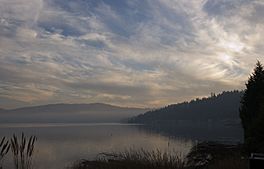Lake Sammamish facts for kids
Quick facts for kids Lake Sammamish |
|
|---|---|
 |
|
| Location | King County, Washington |
| Coordinates | 47°36′59″N 122°05′22″W / 47.6164888°N 122.089427247°W |
| Primary inflows | Issaquah Creek |
| Primary outflows | Sammamish River |
| Basin countries | United States |
| Max. length | 7.3 mi (11.7 km) |
| Max. width | 1.5 mi (2.4 km) |
| Surface area | 19.8 km2 (4,897 acres) |
| Average depth | 58 ft (18 m) |
| Max. depth | 105 ft (32 m) |
| Surface elevation | 30 ft (9.1 m) |
Lake Sammamish is a large freshwater lake located about 8 miles (13 km) east of Seattle in King County, Washington, United States. It is about 7 miles (11 km) long and 1.5 miles (2 km) wide. The deepest part of the lake is 105 feet (32 m) (about 32 meters) and its surface covers 8 sq mi (21 km2).
This lake sits east of Lake Washington and west of the Sammamish Plateau. It stretches from Issaquah in the south all the way to Redmond in the north. Issaquah Creek feeds into the lake at the south end. At the north end, the lake drains into Lake Washington through the Sammamish River. This river is named after the native people who used to live along its banks.
The area that drains into Lake Sammamish is called its watershed. This watershed covers about 98 sq mi (250 km2). It includes parts of Redmond, Bellevue, Issaquah, Preston, and Hobart. Many small creeks flow into the lake, but Issaquah Creek brings in over 70% of the lake's water.
Contents
Growth and Development Around the Lake
The area around Lake Sammamish has grown very quickly in recent years. It is one of the fastest-growing suburban areas near Seattle. Cities like Redmond, Snoqualmie, Fall City, Issaquah, and Bellevue have become much larger. The city of Sammamish was even created in 1999 because of all this new growth.
Protecting Lake Sammamish's Environment
Historically, the forests around Lake Sammamish helped manage the heavy rainfall. The forest soils acted like sponges, soaking up rainwater and slowly releasing it into streams. This helped keep the lake clear and healthy.
However, as more buildings and roads are built, these natural areas are replaced by hard surfaces. This means rainwater runs off quickly, leading to more flooding. This runoff also carries dirt and pollution into the streams and eventually into the lake. This can make the lake water less clear and harm fish and other wildlife.
In 2010, the government asked the town of Sammamish to limit building close to the lakeshore. This was to help protect local fish like salmon and steelhead. Some scientists believe that development has pushed the Lake Sammamish kokanee salmon to the edge of disappearing. The city of Issaquah already has rules that limit building near the lake and its creeks. Sadly, it is thought that fewer than 100 Kokanee salmon are left in Lake Sammamish.
Beavers and the Ecosystem
Recently, beavers have returned to Lake Sammamish. Some officials worry that beavers might cause flooding or dig tunnels under roads. They have suggested moving beaver families to other places. For example, in 2010, officials asked to remove a beaver dam on Tibbetts Creek. They were concerned about flooding and how it might affect salmon moving upstream.
However, other research shows that beavers can be very helpful for the environment. Their dams create ponds that can increase the number and types of fish and birds. Studies in other areas have shown that losing beaver ponds can greatly reduce the number of young salmon and their winter homes.
Fun Activities and Parks
Lake Sammamish is a popular spot for outdoor activities. At the north end, you'll find Marymoor Park. At the south end is Lake Sammamish State Park. The East Lake Sammamish Trail runs along the lake's eastern side.
Lake Sammamish State Park has nine public boat launches. You can use these for a fee, and there is parking and restrooms available. On the west side of the lake, you can visit Redmond's Idylwood Park. There is also a private resort called Vasa Park Resort in Bellevue, which offers lake access for a fee.
Many people enjoy activities like rowing, fishing, waterskiing, wakeboarding, wakesurfing, tubing, and jet skiing. There is even a special course for waterskiing at the north end of the lake.
Fishing is very popular at Lake Sammamish. You can catch many different kinds of fish, including perch, smallmouth bass, largemouth bass, cutthroat trout, salmon, and steelhead trout.
See also
 In Spanish: Lago Sammamish para niños
In Spanish: Lago Sammamish para niños




